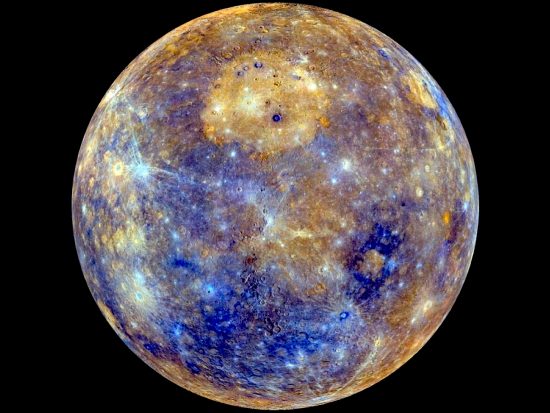
Caloris Basin on Mercury. Image credit: NASA/Johns Hopkins Applied Physics Lab/Carnegie Institution of Washington.
Oct 16, 2017
Mercury reveals an unusual blend of minerals, along with a thin atmosphere.
Editor’s Note: Due to Northern California wildfires, the Picture of the Day will be on a temporary leave of absence. In the interim, please enjoy these articles from the archives.
Of all the rocky bodies in the Solar System, Mercury ranks third in size behind Ganymede and Titan. Mercury is 4878 kilometers in diameter, making it slightly larger than the Moon. Mercury’s mean orbital distance from the Sun is 57,910,000 kilometers, so a year lasts 88 days. Since Mercury rotates every 58.6 days, it completes three rotations for every two orbits. Such close proximity to the Sun, along with its slow rotation, means that temperatures on Mercury can reach 427 Celsius.
Mercury has a thin atmosphere, which creates an anomaly for planetary scientists: how can a planet with such a weak gravity field and with so much “erosion” by solar radiation retain an atmosphere? Mercury receives an average of nine times more radiation at its surface than Earth. The high temperature, as well as bombardment by charged particles should have eliminated any trace of an atmosphere long ago.
Mercury’s weak gravity, in particular, should not be able to keep atmospheric gases from leaking away into space. Rocky moons are thought to be airless deserts because whatever gases they once had were dissipated by the solar wind. Ions can drag neutral gases and dust away, like a stream of water dissolving a riverbank. As conventional thinking suggests, gradually, the atmospheric density should fall to zero. With nothing to protect their surfaces from meteors or coronal mass ejections moons start to look alike because they have all undergone similar evolution over billions of years.
Mercury calls that presumption into question. Some astrophysicists think that the solar wind is powerful enough to knock particles off surface rocks, leaving the ions to recombine in low orbit. Since the molecules do not persist, satellite probes can only detect them as they leak away. How the solar wind knocks enough particles loose is also not known.
The MESSENGER mission to Mercury early in this decade could construct images using eleven different color filters on its Wide Angle Camera (WAC). By combining the information from infrared, visible red, and violet filters, then processing it through red, green, and blue channels, a false-color picture of Mercury’s surface composition could be displayed. That allowed geologists to see variations in chemical distribution and mineral concentration, although what those minerals are is still open to question.
Caloris Basin appears to be geologically different than its surroundings. The craters inside the basin have rims and floors made of something else. Perhaps the dark blue substance came from volcanic events after meteor impacts, or maybe it is the impactors themselves. Presently, no one is sure which minerals correspond to which colors, so it is difficult to be certain of what events caused what outcomes.
When MESSENGER flew by Mercury, unexpected electromagnetic structures known as “flux tubes” were found, connecting it directly with the Sun through twisting Birkeland current filaments. Birkeland currents are well-known to plasma physicists and Electric Universe proponents. They act as cosmic transmission lines through space, confining plasma within their vortices and allowing electric currents to flow over great distances.
As suggested in the recent past, rather than reckoning celestial bodies like Mercury to be geriatric denizens of a wizened Solar System, it is more reasonable, given the anomalies, to think of them as youthful members of a dynamic ensemble. Mercury is probably a relatively young planet and may have come to its present orbit and circumstances within the last 10,000 years. If that is the case, then the presence of an atmosphere of whatever density would not be surprising. The presence of electric currents flowing like giant tornadoes into Mercury hint at a time when those currents might have been far more powerful.
There might have been a period in Mercury’s history when those currents were energized to the glow mode or the arc mode stage. If that happened, then the surface of Mercury would have been the scene of gigantic electric discharges blasting out craters, cutting vast chasms, and rearranging the atomic structure of the planet’s crust over large areas. Caloris Basin and the altered materials in the craters could be part of what has been left behind.
Stephen Smith












